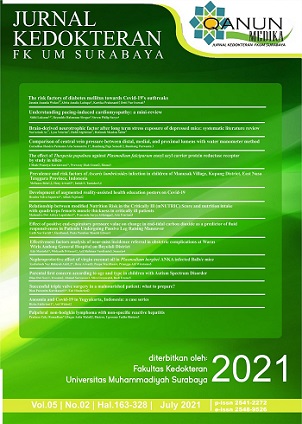Comparison of central vein pressure between distal, medial, and proximal lumens with water manometer method
Abstract
ABSTRACT
Â
Catheter Vein Pressure in ward-cared patients is rarely measured and considered invalid. The two catheter vein pressure postulates contradict, making confusion among health workers. Dr Russo said the distal-medial-proximal Catheter Vein Pressure has no difference but were denied by Susan S. Scott. Proof of postulate is needed as a solution to inward care. Therefore, this study aimed to compare the central vein pressure between distal, medial, and proximal lumens with the water manometer method. Forty-nine samples retrospective study were taken from the distal - medial - proximal Catheter Vein Pressure of the "zero" until fifth days. The differences are analyzed with Statistical Paired t Test with p-Value < 0.05 from SPSS ver. 26 to prove the right postulate. 49 samples were concluded to represent of population. Catheter Vein Pressure from day "zero" becomes zero difference, the fifth day 91.8% are no difference while the rest have difference of 0.2 - 1.0 cm H2O and the conclusion are no significant difference with 95% CI. The correlation scale of 0.998 and 0.999 proves that the three lumens tend to produce no differences. In conclusion, the distal - medial - proximal Catheter Vein Pressure values in this study have no significant differences and consistent from "zero" until fifth days. This is formulated as P distal = P medial = P proximal (cm H2O).
Keywords     : Central Vein Pressure, Pressure, distal - medial - proximal, no differences, ward patient.
Correspondence   : sumantrie_medicalgp@yahoo.com
Full text article
References
Anne Rose, P. et al. (2017). Treatment of Central Venous Access Device Occlusion – Adult / Pediatric / Neonatal–Inpatient Clinical Practice Guideline. February 2. Edited by P. Anne Rose. Wisconsin Madison US: University of Wisconsin Hospitals and Clinics Authority.
Arrow International. (2001). Arrow Central Venous Access Systems. Czech Republic: www.arrowintl.com.
Barke, C. et al. (2008). Monitoring central venous pressure: a survey of British intensive care units. Journal of The Association of Anaesthetists of Great Britain and Ireland, 63, p. 1150.
Blot, F. and Laplanche, A. (2000). Accuracy of totally implanted ports, tunnelled, single and multiple lumen central venous catheters for measurement of central venous pressure. Intensive Care Med (2000), 26, pp. 1837–1842. doi: 10.1007/s001340000705.
Chen et al. (2000). Manual Of Common Bedside Surgical Procedures. 2nd Ed, Manual of Common Bedside Surgical Procedures. 2nd Ed. Edited by H. Chen et al. Philadelphia: Lippincott Williams & Wilkins.
Davidovits, P. (2008). Physics in Biology and Medicine. Third Edit. Edited by P. Davidovits. LONDON: Elsevier Inc. Available at: www.books.elsevier.com/9780123694119/.
Ishikawa, T. (2010). Handbook of PHYSICS in MEDICINE and BIOLOGY. First Edit. Edited by R. Splinter. New York: Taylor and Francis Group, LLC. Available at: http://www.taylorandfrancis.com.
John Santilli, M. (2002). Fibrin Sheaths and Central Venous Catheter Occlusions: Diagnosis and Management. in John Santilli, M. (ed.) Techniques in Vascular and Interventional Radiology. Boston MA USA: Copyright 2002, Elsevier Science (USA). All rights reserved., pp. 89–94. doi: 10.1053/tvir.2002.36048.
Jonuarti, R. (2013). Analisis Aliran Darah dalam Stenosis Arteri Menggunakan Model Fluida Casson dan Power-Law. Jurnal Ilmu Dasar, Vol.14(2), pp. 73–78.
Magder, S. (2005). How to use central venous pressure measurements. Current Opinion in Critical Care, 11, p. 264—270. doi: 10.1097/01.ccx.0000163197.70010.33.
Magder, S. (2006). Central venous pressure monitoring. Current Opinion in Critical Care, 12, pp. 1–9. doi: 10.1097/01.ccx.0000224866.01453.43.
Magder, S. (2012). Bench-to-bedside review: An approach to hemodynamic monitoring - Guyton at the bedside. Magder Critical Care, 16(236), pp. 1–7. doi: 10.1186/cc11395.
Malinoski, D. et al. (2013). Which central venous catheters have the highest rate of catheter-associated deep venous thrombosis: A prospective analysis of 2,128 catheter days in the surgical intensive care unit. Journal of Trauma and Acute Care Surgery, 74(2), pp. 454–462. doi: 10.1097/TA.0b013e31827a0b2f.
Marsha Halfman, RN, M. and Sandra Reiner, RN, BSN, C. (2002). Quick guide to Central Venous Access. First. Edited by M. Marsha Halfman, RN and C. Sandra Reiner, RN, BSN. CHICAGO: Edwards Lifesciences LLC.
Miert, C. van, Hill, R. and Jones, L. (2012). Interventions for restoring patency of occluded central venous catheter lumens. Issue 4. Edited by C. and E. C. G. Cochrane Anaesthesia. Liverpool, UK: John Wiley & Sons, Ltd. doi: 10.1002/14651858.CD007119.pub2.
Miryam M. Reems, DVM, D. and Marcel Aumann, Dr. Med. Vet., DACVECC, D. (2012). Central Venous Pressure: Principles, Measurement, and Interpretation. Compendium: Continuing Education for Veterinarians, 34(1), pp. E1–E10. Available at: https://www.ncbi.nlm.nih.gov/pubmed/22271467.
Sanjiv J.Shah, M. . and Carolyn S. Calfee, M. . (1998). Clinical Procedures In Emergency Medicine. 3rd Ed. Philadelphia: WB SAUNDERS.
Stephen M.Rupp. (2012).Practice Guidelines for Central Venous Access. Practice Guidelines for Central Venous Access A Report by the American Society of Anesthesiologists Task Force on Central Venous Access. Seattle, Washington: Inc. Lippincott Williams & Wilkins., 116(3), pp. 539–73.
Susan S Scott, R. B. C. et al. (1998). Influence of Port Site on Central Venous Catheter Measurements From Tripple Lumen Catheter in Critically Ill Adults, American Journal of Critical Care, 7(1), pp. 60-eoa. doi: TN 688428.
Wolf, J. et al. (2015). Monitoring Central Venous Catheter Resistance to Predict Imminent Occlusion: A Prospective Pilot Study. PLOS ONE|DOI:10.1371/journal.pone.0135904, 0(8), pp. 1–15. doi: 10.1371/journal.pone.0135904.
Wolf Scott W., M. D. (2006). Perioperative Fluid Therapy, Part III. Edited by D. O. A. U. O. T. M. B. O. G. Texas. TEXAS USA: Departement Of Anesthesiology University Of Texas Medical Branch Of Galveston Texas.
Authors

Qanun Medika by FK UM Surabaya is liscence under Lisensi Creative Commons Atribusi 4.0 Internasional.

